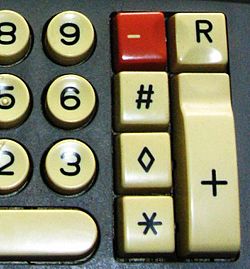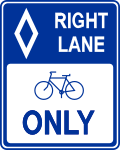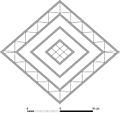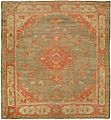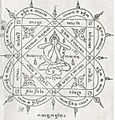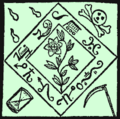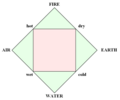Lozenge facts for kids
Quick facts for kids ◊ |
|
|---|---|
|
Lozenge
|
|
A lozenge (which looks like this: ◊) is a special shape, often called a diamond. It's a type of rhombus, which is a four-sided shape where all sides are the same length. Usually, a lozenge is a "thin" rhombus, meaning it has two sharp (acute) angles and two wide (obtuse) angles. Sometimes, its sharp angles are exactly 45 degrees.
This diamond shape is used in many places. You can see it in parquetry (patterns made from wood pieces on floors) and as decoration on things like pottery, silverware, and textiles (fabrics). It's also important in heraldry (family symbols and coats of arms) and on playing cards.
Contents
What Does the Lozenge Symbolize?
The lozenge shape has been around for a very long time! People used it even in the Neolithic and Paleolithic periods in Eastern Europe. Back then, it often stood for a farm field ready for planting and for female fertility (the ability to have children).
You can find this ancient lozenge pattern in:
- Special diamond vault architecture (a type of ceiling design).
- Traditional clothes of Slavic peoples.
- Traditional Ukrainian embroidery.
- Celtic art.
- Art from the Ottoman Empire.
- Ancient Phrygian art.
The lozenge is also a main female symbol in Berber carpets. Many Berber jewelry pieces from the Aurès Mountains or Kabylie in Algeria also use this pattern to represent female fertility.
In 1658, an English thinker named Sir Thomas Browne wrote a book called The Garden of Cyrus. In it, he talked about how the lozenge pattern connects art, nature, and the whole universe. He even thought that ancient gardens were planned in a lozenge shape!
Lozenges also appear as symbols in old ideas about elements (like earth, air, fire, water), in amulets (lucky charms), and in religious symbolism. And, of course, on playing cards, the symbol for the diamonds suit is a lozenge.
How the Lozenge is Used
The lozenge shape isn't just pretty; it has many practical uses too!
In Computers and Calculators
The APL programming language uses the lozenge, which they call "diamond," to separate different commands.
On some equipment, especially calculators, the lozenge marks the "subtotal" key. This is a standard symbol (ISO-7000-0650). In the 1960s, a square lozenge (⌑) was used on banking printouts to show second-level totals.
Camouflage Patterns
During the First World War, the Germans created a special camouflage called Lozenge-Tarnung (lozenge camouflage). This pattern was made from colored shapes, usually four or five different colors. The repeating patterns often used irregular four-, five-, or six-sided shapes, but some had regular diamonds or hexagons.
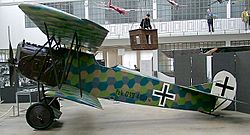
Painting this pattern was very slow, and the paint made the aircraft heavy. So, the pattern was printed directly onto fabric. This pre-printed fabric was used from 1916 until the end of the war, in different forms and colors.
In Heraldry
In heraldry (the study of coats of arms), a lozenge is a diamond-shaped symbol. It's usually a bit taller than it is wide.
- A mascle is a lozenge with a lozenge-shaped hole in the middle.
- A rustre is a rarer lozenge with a round hole in the middle.
If a shield is covered in a pattern of lozenges, it's called lozengy. If it's covered in mascles, it's masculy.
Cough Tablets
Cough tablets are often called "lozenges" because of their original shape. The Oxford English Dictionary says this use of the word started in 1530.
In Finland, the lozenge shape is linked to a salty candy called salmiak. The candy brand Apteekin Salmiakki uses this shape, so the lozenge is often called salmiakkikuvio ("salmiak shape") there. People use this pattern even if the candy isn't actually lozenge-shaped.
Military Use
The lozenge shape is used in the U.S. Army, Marine Corps, and Air Force as part of the rank insignia for their first sergeants.
It's also used in cadet programs like Army ROTC, Army and Marine Corps Junior ROTC, and the Civil Air Patrol. Here, it's part of the rank insignia for cadet officers, showing ranks like Cadet Major, Cadet Lieutenant Colonel, and Cadet Colonel.
In Finnish military ranks, the lozenge is found in the insignia of officer students (one lozenge) and officer candidates (two lozenges).
Transportation Signs
In the United States and Canada, a lozenge (which is technically a mascle) can be painted on roads to mark a special lane. This lane will have lozenges painted on it regularly, and signs will explain who can use it.
This marking is often used for high-occupancy vehicle lanes (HOV lanes, for cars with multiple passengers) or bus lanes. The signs might say "◊ HOV LANE" or "◊ BUS LANE." Before 2006, lozenges were also used for bicycle-only lanes. In Japan and South Korea, a white lozenge on the road means there's an uncontrolled pedestrian crossing ahead.
In the United Kingdom, lozenges are used on tramway signs. For example, speed limits are shown as a black lozenge on a white background, with the speed limit in kilometers per hour inside.
A hollow lozenge is also used on waterway signs to show a danger. If a cross is inside the lozenge, dividing it into four, it means the area is restricted.
Flags and Emblems
Many flags feature lozenges. The Brazilian flag has a large yellow lozenge in its center. One official flag of Bavaria (a state in Germany) is made entirely of blue and white lozenges.

Several emblems also use lozenges, including the Emblem of Uttarakhand, which is a state in India.
Images for kids
-
Cucuteni-Trypillian figurine with sown field pattern
-
Bush Barrow Lozenge British Bronze Age
-
Ushak carpet, Ottoman Empire
-
Muslim Rub el Hizb
-
Magic squares were used as amulets
-
Charlemagne coins, denier or denaro ca. 771-793
-
Belitung shipwreck, Tang Dynasty ca.825
-
Armenian tapestry
-
Rongorongo proto-writing, possible lunar calendar calculating device
-
Epigonation in Eastern Christianity
-
Renault logo
-
National flag of Belarus with sown field pattern
-
National flag of Saint Vincent and the Grenadines


